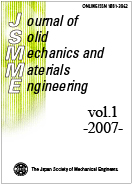Volume 1, Issue 5
Displaying 1-10 of 10 articles from this issue
- |<
- <
- 1
- >
- >|
Papers
-
2007Volume 1Issue 5 Pages 624-634
Published: 2007
Released on J-STAGE: May 31, 2007
Download PDF (1174K) -
2007Volume 1Issue 5 Pages 635-643
Published: 2007
Released on J-STAGE: May 31, 2007
Download PDF (917K) -
2007Volume 1Issue 5 Pages 644-655
Published: 2007
Released on J-STAGE: May 31, 2007
Download PDF (1990K) -
2007Volume 1Issue 5 Pages 656-666
Published: 2007
Released on J-STAGE: May 31, 2007
Download PDF (978K) -
2007Volume 1Issue 5 Pages 667-678
Published: 2007
Released on J-STAGE: May 31, 2007
Download PDF (714K) -
2007Volume 1Issue 5 Pages 679-690
Published: 2007
Released on J-STAGE: May 31, 2007
Download PDF (777K) -
2007Volume 1Issue 5 Pages 691-698
Published: 2007
Released on J-STAGE: May 31, 2007
Download PDF (2796K) -
2007Volume 1Issue 5 Pages 699-710
Published: 2007
Released on J-STAGE: May 31, 2007
Download PDF (1309K) -
2007Volume 1Issue 5 Pages 711-718
Published: 2007
Released on J-STAGE: May 31, 2007
Download PDF (376K) -
2007Volume 1Issue 5 Pages 719-727
Published: 2007
Released on J-STAGE: May 31, 2007
Download PDF (478K)
- |<
- <
- 1
- >
- >|
